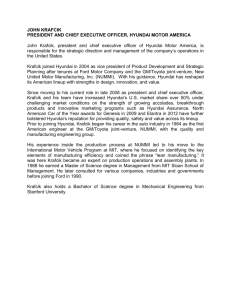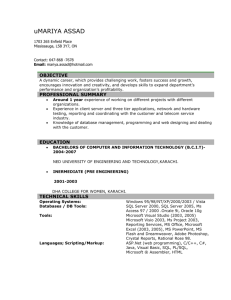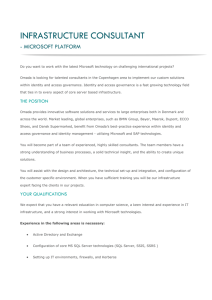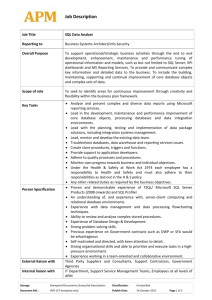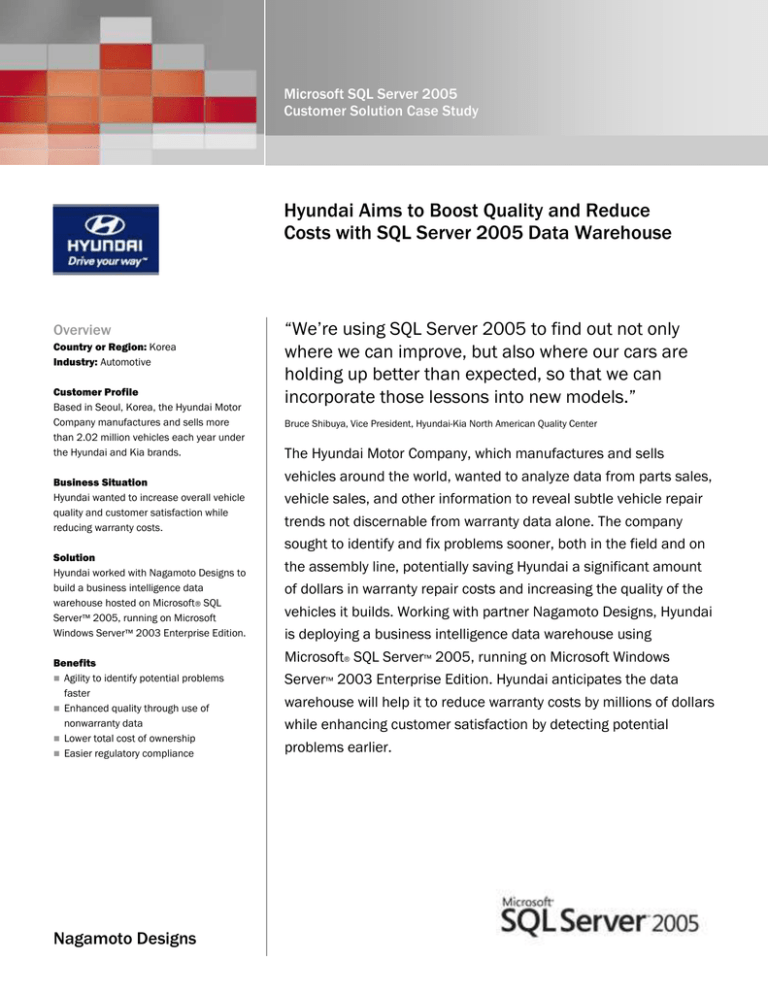
Microsoft SQL Server 2005
Customer Solution Case Study
Hyundai Aims to Boost Quality and Reduce
Costs with SQL Server 2005 Data Warehouse
Solution
Overview
Country or Region: Korea
Industry: Automotive
Customer Profile
Based in Seoul, Korea, the Hyundai Motor
Company manufactures and sells more
than 2.02 million vehicles each year under
the Hyundai and Kia brands.
Business Situation
Hyundai wanted to increase overall vehicle
quality and customer satisfaction while
reducing warranty costs.
Solution
Hyundai worked with Nagamoto Designs to
build a business intelligence data
warehouse hosted on Microsoft® SQL
Server™ 2005, running on Microsoft
Windows Server™ 2003 Enterprise Edition.
Benefits
Agility to identify potential problems
faster
Enhanced quality through use of
nonwarranty data
Lower total cost of ownership
Easier regulatory compliance
Nagamoto Designs
“We’re using SQL Server 2005 to find out not only
where we can improve, but also where our cars are
holding up better than expected, so that we can
incorporate those lessons into new models.”
Bruce Shibuya, Vice President, Hyundai-Kia North American Quality Center
The Hyundai Motor Company, which manufactures and sells
vehicles around the world, wanted to analyze data from parts sales,
vehicle sales, and other information to reveal subtle vehicle repair
trends not discernable from warranty data alone. The company
sought to identify and fix problems sooner, both in the field and on
the assembly line, potentially saving Hyundai a significant amount
of dollars in warranty repair costs and increasing the quality of the
vehicles it builds. Working with partner Nagamoto Designs, Hyundai
is deploying a business intelligence data warehouse using
Microsoft® SQL Server™ 2005, running on Microsoft Windows
Server™ 2003 Enterprise Edition. Hyundai anticipates the data
warehouse will help it to reduce warranty costs by millions of dollars
while enhancing customer satisfaction by detecting potential
problems earlier.
“SQL Server 2005 and
Windows Server
operating system will
give us the power to
expand the quality
system to a global scale.
With the .NET
Framework, we have the
tools to tailor it to the
needs and capabilities
of users.”
Bruce Shibuya, Vice President, Hyundai-Kia
North American Quality Center
Situation
Cars are complicated machines: They break
down and need to be fixed. For anyone who
owns a car, that’s simply a fact of life, but for
automobile manufacturers like the Hyundai
Motor Company, it’s a U.S. automaker’s $12
billion problem. That’s how much money the
auto industry will spend in 2005 on warranty
repairs, according to the Automotive Industry
Action Group, which represents major
automakers and suppliers.
Based in Korea, Hyundai sells vehicles
around the world under the Hyundai and Kia
brand names. In 2004, J.D. Power and
Associates, the global marketing information
firm, ranked the Hyundai Sonata highest in
initial quality for entry midsize cars.
Hyundai constantly seeks ways to improve
quality, and the company uses warranty
claims to identify quality issues. If the number
of field data sources indicates an
abnormality, the Hyundai-Kia North American
Quality Center investigates the potential
indicator. After the root cause has been
determined, the Quality Center works with the
Hyundai and Kia engineering and design
teams to develop a field fix that’s transmitted
to services shops who will be maintaining the
vehicles that are already in use. The Quality
Center also supplies countermeasures, which
are provided to the manufacturing groups to
make the necessary changes on the
assembly line. Last but not least, the problem
is communicated to all design team
members, in an effort to prevent the issue
from appearing on new models.
But while the system will identify costly issues
affecting large numbers of vehicles, Hyundai
wanted a way to discern more subtle
patterns. “We want to catch and fix problems
as early as possible,” says Bruce Shibuya,
Vice President of the North American Quality
Center.
Time is of the essence: Hyundai builds
several million vehicles worldwide each year
in most of its model lines. For every day that
goes by before an issue is resolved, the
company builds several hundred more
vehicles that will eventually have to be fixed.
According to industry trade journal Warranty
Week, a typical warranty repair costs an
automobile manufacturer slightly more than
$200. Even a part that costs pennies on the
dollar can be a significant loss in revenue for
Hyundai.
Hyundai also needed to track vehicles once
they were out of the standard warranty
period, to identify potential quality issues.
Legislation passed in the last few years by
the United States federal government, in
response to the deaths and injuries
attributed to the failure of Firestone tires on
Ford Explorers, has only increased the
pressure on the automotive industry. The
Transportation Recall Enhancement,
Accountability and Documentation Act
requires vehicle and equipment makers to
submit reports summarizing information
about consumer complaints as well as
warranties, legal claims, and field reports to
the National Highway Traffic and Safety
Administration.
Hyundai wanted to build a quality control
system that would integrate several key data
streams in addition to the warranty claim
information.
Solution
Hyundai faced several challenges in
designing its new quality system. Hyundai
also needed to consider issues of scale—the
company wanted to be able to easily
integrate new sources of data as they
became available. Also, the system would
eventually be accessed by a broad range of
users across multiple departments, so
Hyundai needed a great deal of flexibility in
“With SQL Server
Integration Services, we
can easily pull together
data. And we have the
flexibility to collect the
data as soon as
possible.”
Jason Masterman, Consultant, Nagamoto
Designs
designing interfaces and data access rules
for different groups of users.
ETL tool for SQL Server 2005, to gather and
integrate the data that they need.
Finding the Right Solution
Hyundai spent six months evaluating several
proposed solutions, eventually choosing to
work with Nagamoto Designs, and to employ
Microsoft® SQL Server™ 2005 and other
products from Microsoft Windows Server
System™ integrated server software. The
solution includes applications written with the
Microsoft Visual Studio® 2005 development
system and the Microsoft .NET Framework
version 2.0.
Hyundai and Nagamoto Designs expected the
flexibility of the Microsoft tools to simplify the
development of multiple interfaces. “Our
challenge was to write one code base that
would support multiple users who have very
different needs,” observes Masterman. “The
Microsoft tools provide a flexible framework
that enables us to quickly build different
interfaces, a task that would require
extensive custom code if we were using
another solution.”
One of the key factors in the decision was
expense—the initial software and hardware
investment cost Hyundai millions less than
comparable solutions. Also, Hyundai expects
to save thousands of dollars each year on
consultant fees by using its own developers
to modify and maintain the system. The
company already utilized Microsoft software
and technologies and, because of this, its
information technology teams were skilled in
working in a Microsoft software-based
environment.
Development of the project started in July
2004 and is now in its first phase of
deployment.
Hyundai chose to host its new business
intelligence data warehouse on SQL Server
2005, and plans to upgrade it to the 64-bit
version of SQL Server 2005. “Instead of
buying a custom solution, we can build what
we need using SQL Server 2005 and the
[Microsoft] Windows Server™ 2003 operating
system. This will realize a considerable cost
savings,” says Shibuya.
Hyundai will build its data engines off of SQL
Server Analysis Services. “SQL Server 2005
comes with algorithms that we’d have to
purchase separately if were using other
solutions,” says Jason Masterman, a
consultant with Nagamoto Designs. Hyundai
and Nagamoto have also been able to use
SQL Server 2005 Integration Services, the
Architectural Overview
The business intelligence data warehouse
consolidates data from several disparate
systems into a single relational database for
reporting and analysis. Imported data
includes information on vehicle sales,
warranty claims, sale of replacement parts,
and other data points. All this information,
when aggregated, helps to provide insights
into how the company can proactively
enhance the customer experience.
Hyundai’s business intelligence data
warehouse, which is hosted on a HewlettPackard ProLiant DL385 with two processors
and four gigabytes (GB) of RAM, uses a
multitier architecture that includes:
Extract, Transform, and Load (ETL) Tier.
Data from several sources, including flat
files from IBM AS/400 midrange servers, is
imported into temporary tables in SQL
Server 2005 through the SQL Server 2005
Integration Services. To perform ETL.
activities, Integration Services validates the
data before it is loaded into the staging
tier. About 40 Integration Services
packages enable the ETL—most packages
“Instead of buying a
custom solution, we can
build what we need
using SQL Server 2005
and the Windows Server
2003 operating system.
This will realize a
considerable cost
savings.”
Bruce Shibuya, Vice President, Hyundai-Kia
North American Quality Center
were created programmatically using
application programming interfaces (APIs)
built into SQL Server 2005 Integration
Services. “It was impressive to see how
easy it was to automate creating the
packages through the APIs,” notes Chris
Predeek, a consultant with Nagamoto
Designs.
Staging Tier. Using SQL Server 2005
Integration Services, the data loads from
the ETL tier into a temporary table for
staging, where data is scrubbed to
standardize the format, remove duplicates,
and ensure it is ready for loading into the
data warehouse.
Data Tier. Using SQL Server 2005
Integration Services, the data is moved
from the staging tier into the business
intelligence data warehouse, which is
hosted as a relational database on a single
instance of SQL Server 2005. The data
warehouse has several tables, holding
millions of rows of information.
Analytics Tier. Using SQL Server 2005
Analysis Services, the online analytical
processing component in SQL Server,
information from the data warehouse is
organized into multidimensional cubes with
precalculated aggregate data to provide
rapid answers to complex analytical
queries. The solution currently has five
cubes, which have an average of six
dimensions, some of which are related
through other cubes. “Analysis Services
makes a huge difference in processing
queries,” Predeek reports. “Complex
queries that once took 30 seconds to
process now take just 2 seconds with our
Analysis Services cubes.” The analytics tier
is intended for use by some 100 global
specialists within the company. Future
plans call for analytics to be hosted on a
replicated database that will provide realtime access to a read-only version of the
data.
Reporting Tier. Hyundai is preparing to
deploy SQL Server 2005 Reporting
Services, a comprehensive, server-based
solution for creating, managing, and
delivering real-time information to support
daily operations and decisions. The
company will use Reporting Services for
creating predefined reports.
Benefits
The quality system at Hyundai will gather and
analyze data in ways that were previously not
possible, give Hyundai an unprecedented
depth of vision into its products throughout
their life cycles, and help the company
identify problems more quickly.
Agility to Identify Potential Problems
Faster
Hyundai expects that with the quality system,
its companies will be able to catch problems
sooner. This will enable manufacturing teams
to fix them on the assembly line before
thousands more cars are produced with the
same problem and sent into the field, only
later to be fixed at a higher cost. This, in turn,
will reduce warranty expenditures.
“Our plant in Usan, Korea, is one of the
largest automotive plants in the world, and it
produces thousands of vehicles a week,”
advises Shibuya. “If we can fix just one part
on those cars at the assembly line, we could
potentially save a sizeable amount of dollars
in warranty cost.” The quality system will
gather a broader variety of information than
was possible before, as well as reduce the
delay between when the data is generated
and when it is collected and analyzed. “With
SQL Server Integration Services, we can
easily pull together data,” says Masterman.
“And we have the flexibility to collect the data
as soon as possible.”
Enhanced Quality Through Use of Nonwarranty Data
In addition to revealing potential problems
more quickly, having information beyond the
warranty data traditionally used to monitor
quality will help the Hyundai-Kia North
American Quality Center to identify problems
on cars with extended mileage. This will
reduce the companies’ need for possible field
actions for repairs on older vehicles, as well
as help the companies to increase long-term
quality. For example, in June, 2004, DaimlerChrysler agreed to issue a recall to repair an
airbag problem that affected almost 1 million
minivans built between 1998 and 2000,
when three-year or 36,000-mile warranties
were the norm.
“The National Highway Traffic and Safety
Administration doesn’t have a statute of
limitations on recalls," explains Shibuya, “We
expect that the system that we’re building
with Microsoft tools will help us to reduce our
exposure to those sorts of incidents.”
Hyundai sees the opportunity to continue to
improve vehicle quality by increasing the
long-term reliability of the companies’ cars.
“How well cars hold up after 5, 10, or 15
years has a huge impact on the consumer's
perception of an automaker’s quality,” says
Shibuya. “We’re using SQL Server 2005 to
find out not only where we can improve, but
also where our cars are holding up better
than expected, so that we can incorporate
those lessons into new models.”
Lower Total Cost of Ownership as
Deployment and Maintenance to Cost
Millions Less
The Hyundai-Kia North American Quality
Center and Nagamoto Designs chose
Microsoft products and technologies to build
the system because development,
deployment, and maintenance would cost
significantly less than the alternatives.
“Several companies came in trying to sell
software that would cost millions to purchase
and millions more to modify,” says Shibuya.
“After that, it still wouldn’t be the company's
application, because we would have to pay a
consultant $250,000 each year to maintain
and adjust it. With Nagamoto Designs and
Microsoft, we chose an architecture that can
grow and change as we need it to.”
And from a development perspective, the
Quality Center teams are excited about the
performance that SQL Server 2005 provides,
combined with the easy integration with
programs in the Microsoft Office System.
“SQL Server 2005 and Windows Server 2003
will give us the power to expand the quality
system to a global scale,” says Shibuya. “With
the .NET Framework, we have the tools to
tailor it to the needs and capabilities of
users.”
Easier Regulatory Compliance with
Improved Data Collection
Although improving quality and cutting costs
are strong motivators, Hyundai executives
also expect the quality system to simplify
compliance with the Transportation Recall
Enhancement, Accountability, and
Documentation Act. Hyundai employees will
be able to more quickly identify and resolve
problems, even when the existing data might
be sparse.
For example, in August 2004 the National
Highway Traffic and Safety Administration
opened an investigation of the ball joint on
Toyota Tundra trucks based on three reports
of failure. Toyota had received 28 warranty
claims for ball-joint wear and 15 consumer
complaints of a ball joint coming apart, one of
which resulted in a crash.
“That number of warranty claims may not
have crossed the threshold to trigger an
internal quality investigation,” concludes
Shibuya. “We expect that our system will be
able to detect and flag problems like that
after only a few repair incidents, whether or
not there is a warranty claim.”
For More Information
Microsoft Windows Server System
For more information about Microsoft
products and services, call the Microsoft
Sales Information Center at (800) 4269400. In Canada, call the Microsoft
Canada Information Centre at (877) 5682495. Customers who are deaf or hard-ofhearing can reach Microsoft text telephone
(TTY/TDD) services at (800) 892-5234 in
the United States or (905) 568-9641 in
Canada. Outside the 50 United States and
Canada, please contact your local
Microsoft subsidiary. To access information
using the World Wide Web, go to:
www.microsoft.com
Microsoft Windows Server System is a line of
integrated and manageable server software
designed to reduce the complexity and cost
of IT. Windows Server System enables you to
spend less time and budget on managing
your systems so that you can focus your
resources on other priorities for you and your
business.
Microsoft SQL Server 2005 is
comprehensive, integrated data management
and analysis software that enables
organizations to reliably manage missioncritical information and confidently run
today’s increasingly complex business
applications. By providing high availability,
security enhancements, and embedded
reporting and data analysis tools, SQL Server
2005 helps companies gain greater insight
from their business information and achieve
faster results for a competitive advantage.
And, because it’s part of Windows Server
System, SQL Server 2005 is designed to
integrate seamlessly with your other server
infrastructure investments.
For more information about Windows Server
System, go to:
www.microsoft.com/windowsserversystem
For more information about Nagamoto
Designs products and services, call (949)
244-3318 or visit the Web site at:
www.nagamotodesigns.com
For more information about SQL Server
2005, go to:
www.microsoft.com/sqlserver
For more information about Hyundai Motor
Group products and services, call (909)
993-5401 or visit the Web site at:
www.hyundai.com
Software and Services
Hardware
Microsoft Windows Server System
− Microsoft Windows Server 2003
Enterprise Edition
− Microsoft SQL Server 2005
Microsoft Visual Studio .NET 2003
Technologies
− SQL Server 2005 Analysis Services
− SQL Server 2005 Reporting Services
© 2005 Microsoft Corporation. All rights reserved. This case
study is for informational purposes only. MICROSOFT MAKES NO
WARRANTIES, EXPRESS OR IMPLIED, IN THIS SUMMARY.
Microsoft, Visual Studio, the Windows logo, Windows Server,
and Windows Server System are either registered trademarks or
trademarks of Microsoft Corporation in the United States and/or
other countries. All other trademarks are property of their
respective owners.
Document published October 2005
Microsoft SQL Server 2005
HP ProLiant DL385 with two processors
and 4 GB of RAM
Partner
Nagamoto Designs



